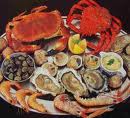Seafoods are actually and remarkably safe to eat. It accounts for no more than ten percent of all the reported food-borne diseases.
Nevertheless, seafood-borne disease cause a significant number of illness and deaths worldwide, and people should be wary of them.
Most health problems associated with seafood are due either to contaminants that are present in the environment where the seafoods (i.e. shellfish or fish) are grown or improper handling.
Many shellfish like oysters, muzzles, clams, etc. hardly move, hence, they need to filter a lot of water to obtain food. In the process disease causing bacteria, viruses and other microorganism that are present in their immediate environment tend to accumulate and concentrate in them.
It is thus, risky to eat raw or half cooked shellfish that are grown and harvested in polluted waters because of the possibility of food poisoning.
Pathogenic bacteria can also grow in a stale and poorly handled fish, but fresh and properly prepared deep sea fish can be eaten raw.
Another health risk that shellfish carry on a seasonal basis is red tide. Red tide which occurs at certain times of the year, is caused by the proliferation of dinoflagellates, a type of phytoplanktons that exude a lethal toxin. Dinoflagellate toxin is not destroyed by cooking.
In fish, removal of the entrails or abdominal organs before cooking makes the fish ready for human consumption, but there is no way to remove dinoflagellate toxin from shellfish. Hence, when the red tide warning is up, people should refrain from eating shellfish.
The dumping of chemical pollutants into the sea is an additional growing concern associated with seafoods because their chemicals find their way into the food chain and accumulate in the tissues of sea creatures.
Most seafood-borne diseases can be traced to pollution in the area where the sea creatures are harvested. Seafood-borne illnesses are best prevented by proper monitoring of the fish industry by the concerned government agencies.
At the personal level as consumer, people can help prevent these diseases by observing the following precautions:
1.) Eat only shellfish and fish that are cultured or harvested from known safe areas.
2.) Remove the entrails of fish before storing them in the freezer.
3.) Preferably, shellfish and fish should be cooked thoroughly before they are consumed. Eat seafood raw only if they are fresh and handled properly. Seafood that are safe to eat are deep sea fish. Fresh water fish have to be cooked because some of the parasites they carry can also caused illness in humans.
4.) Keep raw or live seafood separate from cooked seafood.
5.) Wash knives, chopping boards, and cooking utensils with soap and water before using them to prepare seafood.
6.) Observe proper personal hygiene before handling seafood.
